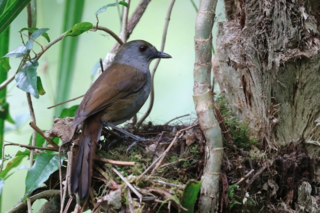
Pomatorhinus is a genus of scimitar babblers, jungle birds with long downcurved bills. These are birds of tropical Asia, with the greatest number of species occurring in hills of the Himalayas.

The grey-cheeked tit-babbler is a species of bird in the family Timaliidae. It is endemic to Java.
Micromacronus is a bird genus in the family Cisticolidae endemic to the Philippines. Long considered to be monotypic, its members are known as miniature babblers or miniature tit-babblers. As the scientific as well as the common names indicate, their habitus resembles a diminutive version of the tit-babblers (Macronus). The genus was only described in 1962, upon the description of the first species, which had been collected by collector Manuel Celestino and Godofredo Alcasid, a zoologist at the Philippine National Museum. The genus was formerly placed in the family Timaliidae but a molecular phylogenetic study published in 2012 found that the genus was more closely related to species in the family Cisticolidae.

Crossley's vanga, also known as Crossley's babbler-vanga, Crossley's babbler, Madagascar groundhunter, or Madagascar groundjumper, is a bird species in the family Vangidae.

The fire-tailed myzornis is a bird species. Its genus Myzornis is monotypic, and has recently been placed in the family Paradoxornithidae.

The pied shrike-babbler is a bird species traditionally considered an aberrant Old World babbler and placed in the family Timaliidae. But as it seems, it belongs to an Asian offshoot of the American vireos and may well belong in the Vireonidae. Indeed, since long it was noted that their habits resemble those of vireos, but this was believed to be the result of convergent evolution.

The Sikkim wedge-billed babbler or blackish-breasted babbler is a species of bird in the Old World babbler family (Timaliidae). It is named for the Indian state of Sikkim.

The golden babbler is a babbler species in the family Timaliidae. It occurs from the foothills of the Eastern Himalayas to Southeast Asia and inhabits subtropical lowland and montane forests. It is listed as Least Concern on the IUCN Red List because of its wide distribution.

The chestnut-winged babbler is a babbler species in the family Timaliidae. It occurs in the Malay Peninsula from southern Thailand to Singapore, and in Sumatra. It inhabits forests and shrublands up to an elevation of 800 m (2,600 ft). It is listed as Least Concern on the IUCN Red List.

The crescent-chested babbler is a babbler species in the family Timaliidae and is native to the Indonesian islands of Java and Bali. It inhabits subtropical or tropical moist lowland forest, montane forest and shrubland. It is listed as Least Concern on the IUCN Red List.

The black-chinned babbler is a babbler species in the family Timaliidae. It occurs in the foothills of the Himalayas from the Murree Hills in Pakistan to eastern Nepal. It inhabits subtropical and temperate forest at 245–2,750 m (804–9,022 ft) altitudes. It is listed as Least Concern on the IUCN Red List.

The rufous-capped babbler is a babbler species in the family Timaliidae. It occurs from the Eastern Himalayas to northern Thailand, Laos, eastern China to Vietnam and Taiwan. It inhabits temperate forest with dense bushes or bamboo and is listed as Least Concern on the IUCN Red List.

The rufous-fronted babbler is a babbler species in the Old World babbler family. It occurs from the Eastern Himalayan foothills to Southeast Asia at altitudes of 120–2,100 m (390–6,890 ft).

The Bagobo babbler or Bagobo robin is a monotypic species of bird with its taxonomy undergoing numerous changes and is currently classified as Muscicapidae or an old world flycatcher. It is endemic to the Philippines only found in Mindanao.

Hartlaub's babbler or the Angola babbler, is a species of bird in the family Leiothrichidae, which is native to south central Africa. The common name and Latin binomial commemorate the German physician and ornithologist Gustav Hartlaub.

The Taiwan cupwing or Taiwan wren-babbler is a species of passerine bird in the family Pnoepygidae. The species is endemic to the island of Taiwan. It was treated for a long time as a subspecies of the scaly-breasted cupwing.

The clicking shrike-babbler is a species of bird in the family Vireonidae. It is found from Assam, India, eastern Myanmar to southern China, and southern Vietnam. Its natural habitats are subtropical or tropical moist lowland forests and subtropical or tropical moist montane forests. It used to be considered a subspecies of the chestnut-fronted shrike-babbler.

The trilling shrike-babbler is a species of bird in the family Vireonidae. It is endemic to the island of Java. Its natural habitats are subtropical or tropical moist lowland forests and subtropical or tropical moist montane forests. It used to be considered the nominate subspecies of the chestnut-fronted shrike-babbler.

The Dalat shrike-babbler is a bird subspecies traditionally considered an aberrant Old World babbler and placed in the family Timaliidae. But as it seems, it belongs to an Asian offshoot of the American vireos and may well belong in the Vireonidae. Indeed, since long it was noted that their habits resemble those of vireos, but this was believed to be the result of convergent evolution.

Mixornis is a genus of passerine birds in the Old World babbler family Timaliidae.





















